America's Secret Commandos
Trained to infiltrate, observe and fight under any conditions, special operations forces are becoming our first line of defense in a complex, post Cold War world.
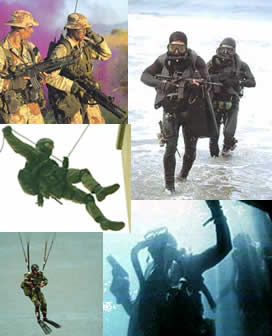 A small band of elite warriors crouches beneath the sands of Western Iraq. Buried in their carefully constructed hide site, the Green Berets are visible for no more than a few yards, but they command a clear view of passing enemy traffic. Their mission is special reconnaissance, giving the XVIII Airborne Corps eyes and ears in the desert.
A small band of elite warriors crouches beneath the sands of Western Iraq. Buried in their carefully constructed hide site, the Green Berets are visible for no more than a few yards, but they command a clear view of passing enemy traffic. Their mission is special reconnaissance, giving the XVIII Airborne Corps eyes and ears in the desert.
Half a world away, and several months later, a detachment of Navy SEALs sneaks into Haiti. Top aides to the country's democratically elected president Jean-Bertrand Aristide are threatened by the military strongman who now holds power. Someone has to get them out.
In Panama, a few minutes into Operation Just Cause, Delta Force storms Modelo Prison, where American Kurt Muse is being held by Gen. Manuel Noriega. Unless rescued, Muse, arrested for running a secret radio station, could become the focus of a heart-rending hostage drama. Scenes like these are enough to make many in the American military wish for the quiet tension of the Cold War. To protect American interests, they must now be ready to react whenever and wherever a crisis may occur. And the reaction must be swift, decisive and precisely tailored to the situation at hand.
Stepping into the breach is an elite breed of soldier originally trained to fight on the fringes of full-scale wars, but now more likely to bear the brunt in conflicts where stealth and cunning outweigh brute force. Collectively known as special operations forces, these often secretive soldiers work in small, cohesive fighting groups, travel light and fast, use the most exotic weapons and equipment, and are masters of infiltration and escape. Most important of all, they must be able to adapt, cooking up their own "field expedients" when, as inevitably happens in war, they encounter problems that no amount of training or equipment can prepare them for.
As a result, the tools and tactics of these special warriors are as diverse as their missions. But with the creation of the United States Special Operations Command (USSOCOM) in 1987, they have found a unified and newly prominent identity. Members of the Army, Navy and Air Force now work together within this structure, complemented by select Marine Corps units. Together, they form a coordinated yet uniquely flexible fighting force. Many consider it to be our best hope for stability and safety in the new world order.
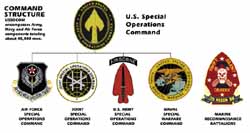
USASOC
The Army makes up the largest component of the USSOCOM forces. Under the authority of the U.S. Army Special Operations Command (USA- SOC) are the Rangers, the Special Forces groups, the 160th Aviator Regiment, and Civil Affairs and Psychological Operations units. Best known among these, and most representative of the special warfare concept, are the Special Forces, otherwise known as the Green Berets.
The Green Berets are trained to function in 12-man units called operational detachments (ODAs), or A- teams. Organized as tiny, self- sufficient armies, A-teams thrive on specialization. Two on each team are experts in weapons, two specialize in combat engineering and demolition, two are medics, and two handle communications. The doubling up in each area means the detachment can break up into two "split teams" and retain the same range of expertise.
Green Berets have a lot more leeway way than conventional forces in deciding what they'll carry on a mission But they tend to stick to a small stock of well-proven arms, many of which are also used by the special operations forces of the other services.
Guns
Two snipers provide the long-range firepower of an ODA. Each is issued the Army's M24 sniper system, which builds around a highly modified Remington M700 rifle, firing 7.62mm match-grade ammunition. About all that remains of the original civilian gun is the bolt-action firing mechanism. The stock is made of Kevlar graphite, and a heavy, stainless-steel barrel has been fitted. The barrel floats freely within the stock to prevent irregular vibrations that could compromise accuracy. Sighting is through a 10-power Leupold scope.
Snipers almost always work in pairs- one shooting, the other watching through a 20-power spotting scope. The spotter follows the air vortices that trail each round and calls out corrections for the next shot. Officially, the effective range of the M24 is 800 yards. But Green Berets I spoke to said that a well-trained sniper should be able to make consistent hits out to 1000 yards.
An innovative, ferocious weapon that has broadened the sniper's role is the Barrett 82A1 .50- caliber semi-automatic rifle. Firing the ammunition of a heavy machine gun, the "light fifty" can stop light armor at more than 2000 yards yet weighs less than 30 pounds. A unique muzzle brake jets propellant gases backward, reducing recoil to about that of a 12- gauge shotgun. Eleven rounds can be squeezed off from the detachable box magazine before reloading.
Despite their broad experience with unusual arms, most Special Forces express surprising affection for the standard-issue M16A2 as an all-around assault rifle. Bugs that plagued earlier M16 variants are apparently ironed out, leaving it a rugged, reliable, easy- to- handle weapon. Usually, two members of an ODA will pack M16A2s, with M203 40mm grenade launchers mounted under the barrels. The breech-loading launcher can lob explosives up to 400 meters.
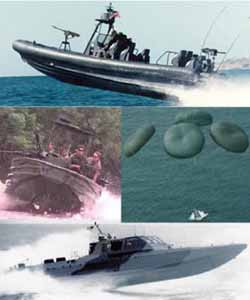 Special Forces' weapons proficiency must encompass foreign arms, as well. From early on, an important part of their mission has been to train the troops of friendly nations. That means they must be prepared to instruct in the use of whatever weapons happen to be around. The Soviet AK-47 assault rifle (called the AK-74 when in the U.S. inventory) is one of the most common. Special Forces soldiers compare the AK-47 unfavorably to the M16, faulting its heavier weight, shorter range and wildness in full automatic mode. Other weapons Special Forces may use on training missions include the heavy German G3 assault rifle and the Israeli UZI submachine gun.
Special Forces' weapons proficiency must encompass foreign arms, as well. From early on, an important part of their mission has been to train the troops of friendly nations. That means they must be prepared to instruct in the use of whatever weapons happen to be around. The Soviet AK-47 assault rifle (called the AK-74 when in the U.S. inventory) is one of the most common. Special Forces soldiers compare the AK-47 unfavorably to the M16, faulting its heavier weight, shorter range and wildness in full automatic mode. Other weapons Special Forces may use on training missions include the heavy German G3 assault rifle and the Israeli UZI submachine gun.
Sights and optics
Making every shot count is key for Special Forces units, so they rely on advanced optical equipment to find and fire upon their targets. For general use in night operations, each ODA is issued four sets of AN/PVS- 7As, the latest generation of night vision goggles. They amplify light efficiently enough that objects 300 to 400 yards away are visible even on moonless nights. In pitch darkness, a small infrared illuminator switches on, providing short-range visibility.
Laser aiming lights are coming into wider use for night work. Aligned with the rifle's barrel, the laser projects a dot of light that marks exactly where the round will hit. Special Forces use the AN/PAQ-4, a light- weight, cylindrical unit that throws out a flashing infrared beam visible only with night-vision goggles.
Light-amplifying devices such as night-vision goggles don't help in seeing through smoke or fog. Such conditions require much larger and more complex devices that pick up tiny variations in temperature. During Operation Desert Storm, Special Forces used the AN/TAS-6 thermal acquisition sight. Although it weighs close to 70 pounds and requires the regular replacement of batteries and liquid- nitrogen coolant bottles, it proved to be highly effective for fixed observation posts. With magnification reaching 12-power, users report being able to spot rats a mile away.
Another optical device that proven itself in Desert Storm is the AN/PAQ-4 laser target designator. This rifle- like ray gun helps artillery and attack aircraft find their marks by illuminating them with a beam that laser- guided munitions can follow. Waterproof and a little under 15 pounds, the PAQ-1 can easily be carried on infiltration behind enemy lines. Three knobs are used to dial in prearranged codes that make sure the right projectile tracks the right target.
Communications gear
Advancing electronics technology has made it easier for Green Berets to stay in touch without compromising security. For example, all an A-team needs to maintain contact with state- side commanders is a 12-pound satcom radio called an LST-5C. In a few minutes, a spring- loaded folding antenna is deployed, aimed with a compass, then hooked to the radio with a coaxial cable. After a few signals are bounced off the satellite to fine- tune the aim, the system is ready.
Compact as the LST-5C is, teams carry it only on missions that absolutely require real-time contact with their home base. Usually, they get by with lighter VHF and HF radios from the conventional military inventory.
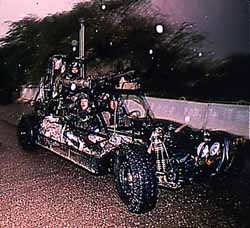
Vehicles
Special Forces train to get to and from their objectives by just about any means imaginable. Recently, new transport hardware has opened new options.
Parachute drops are a preferred method of infiltration, but Green Beret capabilities go well beyond the en- masse static- line jumps practiced by normal airborne units. Wing- like ram air canopies adapted from sport parachutes entered service in the mid-'80s. Their accuracy and flexibility are crucial in high altitude low opening (HALO) and high altitude high opening (HAHO) jumps. HALO is a way of dodging detection by jumping from an altitude of up to 25,000 ft., then freefalling to about 4000 ft. before opening the canopy. HAHO keeps the aircraft out of harm's way. It involves pulling the ripcord a few seconds after jumping, then gliding several miles to the drop zone.
For HALO and HAHO jumps, Special Forces use the MTI-XX, a highly modified civilian ram air chute that can glide at airspeeds up to 25 mph.
For the high-altitude leg of a HALO or HAHO deployment, jumpers breathe from two compressed oxygen "bailout bottles." A chest-mounted magnetic compass normally guides them to the drop zone on HAHO jumps, but recently, compact Global Positioning System (GPS) satnav units have tested favorably. Rucksacks are strapped around the thighs during descent, then kicked loose about 10 ft. off the ground.
In the wake of the disastrous Iranian hostage rescue attempt in 1980, tremendous effort has been devoted to modifying helicopters and training their pilots to insert and extract men under the most adverse conditions. The Army's 160th Aviation Regiment has spearheaded this research for more than a decade. Crews go through a harrowing selection process and then fly at the very edge of the envelope for night and foul-weather operations. The cost has been high, with many helicopters and crews lost in training, but the result is capability that simply didn't exist a decade ago.
The 160th recently took delivery of two new helicopters configured specifically to their requirements. The MH-60K is a variant of the UH-60 Black Hawk utility copter, packed to the gills with advanced avionics. It has terrain- following radar and a forward- looking infrared sensor for all- weather map- of- the- earth flight through hostile territory. An air-to- air refueling boom, and two fuel tanks extend range. Displays in the custom- built cockpit are designed for ease of use with night-vision goggles.
The MH-47E swings into action for heavier cargo. The venerable twin- rotor Chinook airframe is barely recognizable beneath a load of special equipment. Avionics are similar to the MH-60K's, while internal fuel tanks give it the longest un- refueled range of any Army helicopter.
To provide air support as mobile as a Special Forces unit, the AH-6J Special Attack Aircraft was developed. Based on a small, 2-seat civilian helicopter. the AH-6J fits aboard a C-130 cargo plane, and can be unpacked and ready to fly 5 minutes after arrival. Armament includes 2.75-in. rocket pods and Gatling- type 7.62 miniguns.
Overland transport tactics have also been updated. Special mobility ODAs are now entering service, each equipped with four HMMWVs (better known as Hummers), three trailers and two lightly modified Kawasaki KLR-250 enduro motorcycles. Brimming with spare parts and fuel, the units are self-sufficient over ranges up to 1200 miles. In their primary mission- insertion and extraction of Special Forces teams- they can carry a fully equipped ODA in addition to themselves. To help manage the heavy load, the Hummers' doors are removed and their bulletproof Kevlar tops strategically cut away. The motorcycles offer high speed over rough terrain. They are used primarily for advance scouting and linkups with other units.
For waterborne infiltration, Green Berets recently adopted the Klepper folding kayak. It can carry two men and hundreds of pounds of equipment silently at 5 miles per hour. On land, it disassembles in 5 minutes into an 80- pound package portable by one man.
In addition to the Special Forces and the 160th Aviation Regiment, USASOC oversees the 75th Ranger Regiment. The Rangers are essentially cream- of-the- crop light- infantry soldiers. Their specialties include ambushes, urban warfare and lightning attacks to temporarily seize key objectives. They also share many of the Special Forces' infiltration skills.
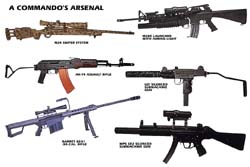
Navy SEALS
Navy SEALS (Sea-Air-Land units) came into being in 1962, an outgrowth of the earlier Underwater Demolition Teams (UDTs). As the name suggests, they are versatile special warriors trained for just about any environment. Like the Special Forces, SEALs operate in small groups of individual specialists. The standard platoon has 14 to 20 men, and can break down into two squads, or boat teams.
The SEALs' forte is infiltration. In keeping with their frogman roots, they have the most extensive combat swimmer training in the armed forces. It begins with the 25-week Basic Underwater Demolition/SEAL course (BUD/S), an ordeal that has no match in the U.S. military. Boat crews carry 300-pound logs on 14-mile beach runs and go for six days on 3 hours of sleep. Those that survive possess tremendous mental and physical endurance, and a keen appreciation for the power of teamwork.
In addition to infiltration by swimming, the SEALs learn HALO and HAHO parachuting, and are proficient in tactics involving aircraft, boats, land vehicles and submersibles. Their bread-and-butter play is the Rubber Duck Op, in which a squad and its combat rubber raiding craft (CRRC) parachutes into the water from a C-130. They then fire up the boat's specially silenced 35- hp outboard and head for land, guns trained on the shoreline.
They may also approach the objective underwater. Standard breathing apparatus is the LAR V (Lambertson Amphibious Respiratory unit), which emits no telltale bubbles and can sustain a diver for hours. SEALs usually wear a standard wet suit or dry suit, an inflatable buoyancy compensator to keep them swimming at the desired depth, and a black balaclava for warmth and camouflage.
SEAL weaponry is chosen to make engagements short, sharp and overwhelming, since platoons can't carry enough ammunition for sustained fighting. Accordingly, they like weapons that quickly put a lot of lead in the air. For close-in fighting, the Heckler and Koch MP5 series of sub- machine guns ranks high, because of its accuracy and rate of fire. Since Vietnam, the pump action 12-gauge shotgun has also been a SEAL trademark, especially the Ithaca Model 37 and Remington 870.
Other commonly used weapons include the M16A2 with M203 grenade launcher, and the M60E3 7.62mm machine gun, a lightweight variant of the standard-issue M60. To dispatch sentries, the standard Beretta M9 9mm pistol may be equipped with a silencer and subsonic ammunition. Interestingly, the SEALs may be the last U.S. force still using the old M14 rifle which fires truer farther than the M16, and works well when wet.
Vehicles
Besides the standard CRRC, SEALs use various watercraft. One of the newest is the 24-ft. Rigid Inflatable Boat (RIB). With a fiberglass hull ringed by an inflatable gunwale it can stay upright and afloat in incredibly heavy weather. Its 165-hp turbodiesel engine propels it at better than 30 mph. A 4-man SEAL element usually rides with the 2-man crew.
The SEALs' most peculiar mode of transportation is probably the SEAL Delivery Vehicle (SDV). Launched from surface vessels or submarines, these tiny, free- flooding submersibles let SEALs travel faster and farther underwater than they could by swimming. The 21-ft. SDV Mark VIII is the most widely used. Powered by rechargeable batteries running a DC motor, it carries four SEALs, a pilot and a navigator in fully enclosed compartments. Computerized Doppler navigation sonar and obstacle avoidance sonar guide the crew.
SEALs also have their own unique way of traveling over land. The Fast Attack Vehicle, which first saw service in the recapture of Kuwait, is essentially a Chenowth 2-wheel-drive off-road racing vehicle. Light and agile, it can handle most of the same terrain as the 4wd Hummer, but at higher speed. It is well armed, with a Mark 19 automatic grenade launcher, a .50- caliber machine gun, M60 machine guns, a 30mm cannon and an AT-4 anti-tank missile launcher.
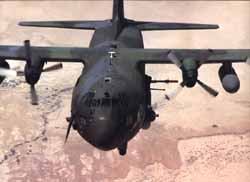 AC-130U GUNSHIP
AC-130U GUNSHIP
Air Force Special Operations Command
The main role of the Air Force in special operations is to transport men and material, often into hostile territory and under harsh conditions. Several fixed- wing and rotary- wing aircraft have been modified for the purpose.
Two new pieces of hardware are the MC-130H Combat Talon II and the AC-130U Spectre gunship. The Combat Talon is outfitted for low-altitude, deep- penetration transport missions with an aerial refueling boom, explosion suppressive fuel tanks, an AN/ APQ-170 terrain following radar, and just about every type of navigational device imaginable. On missions where vertical takeoff and landing are required, the mammoth MH-53J Pave Low IIIE takes over the heavy lifting. The 42,000-pound helicopter is air refuelable and its avionics are every bit as comprehensive as the Combat Talon's.
Like its predecessors, the Vietnam-era "puff" gunships, the AC- 130U is designed to bring enormous firepower to bear in support of ground forces. But where the earlier craft simply saturated whole areas with projectiles, the new aircraft uses state-of-the-art sensors and fire control equipment to steer its 105mm howitzer, and 25mm and 40mm cannons with great precision.
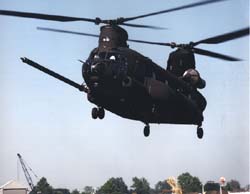 MH-47E CHINOOK
MH-47E CHINOOK
Joint Special Operations Command
Headquartered at Pope Air Force Base, North Carolina, the JSOC is a small USSOCOM component comprising elements from the Air Force, Army and Navy. Its ostensible mission is to ensure standardization among the special operations forces of each service, but it also has responsibility for SEAL Team 6 and Special Forces Detachment Delta (better known as Delta Force), two highly secretive counterterrorist units.
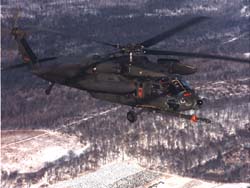 MH-60K
MH-60K
Marine Reconnaissance Units
The Marine Corps is of two minds about the concept of special operations forces. On one hand, they contend, the run- of- the- mill Marine meets standards that would qualify him for special warfare duty in another branch of services. On the other, there's always room for people with extra training in key areas.
Although surveying and preparing a beach for an amphibious assault is a SEAL responsibility, the Marines also have their own units devoted to that role. The Marine Reconnaissance Battalions receive special training in infiltration, hydrographic reconnaissance, surveillance and spotting for Naval gunfire. Unlike the SEALs, their missions are generally limited to observation, and they generally avoid contact with the enemy. There are, however, Marine units known as Force Recon Companies that support amphibious assaults by carrying out raids and demolition activities similar to those of the SEALs and Green Berets.
 A small band of elite warriors crouches beneath the sands of Western Iraq. Buried in their carefully constructed hide site, the Green Berets are visible for no more than a few yards, but they command a clear view of passing enemy traffic. Their mission is special reconnaissance, giving the XVIII Airborne Corps eyes and ears in the desert.
A small band of elite warriors crouches beneath the sands of Western Iraq. Buried in their carefully constructed hide site, the Green Berets are visible for no more than a few yards, but they command a clear view of passing enemy traffic. Their mission is special reconnaissance, giving the XVIII Airborne Corps eyes and ears in the desert.
 Special Forces' weapons proficiency must encompass foreign arms, as well. From early on, an important part of their mission has been to train the troops of friendly nations. That means they must be prepared to instruct in the use of whatever weapons happen to be around. The Soviet AK-47 assault rifle (called the AK-74 when in the U.S. inventory) is one of the most common. Special Forces soldiers compare the AK-47 unfavorably to the M16, faulting its heavier weight, shorter range and wildness in full automatic mode. Other weapons Special Forces may use on training missions include the heavy German G3 assault rifle and the Israeli UZI submachine gun.
Special Forces' weapons proficiency must encompass foreign arms, as well. From early on, an important part of their mission has been to train the troops of friendly nations. That means they must be prepared to instruct in the use of whatever weapons happen to be around. The Soviet AK-47 assault rifle (called the AK-74 when in the U.S. inventory) is one of the most common. Special Forces soldiers compare the AK-47 unfavorably to the M16, faulting its heavier weight, shorter range and wildness in full automatic mode. Other weapons Special Forces may use on training missions include the heavy German G3 assault rifle and the Israeli UZI submachine gun. 

 AC-130U GUNSHIP
AC-130U GUNSHIP MH-47E CHINOOK
MH-47E CHINOOK  MH-60K
MH-60K